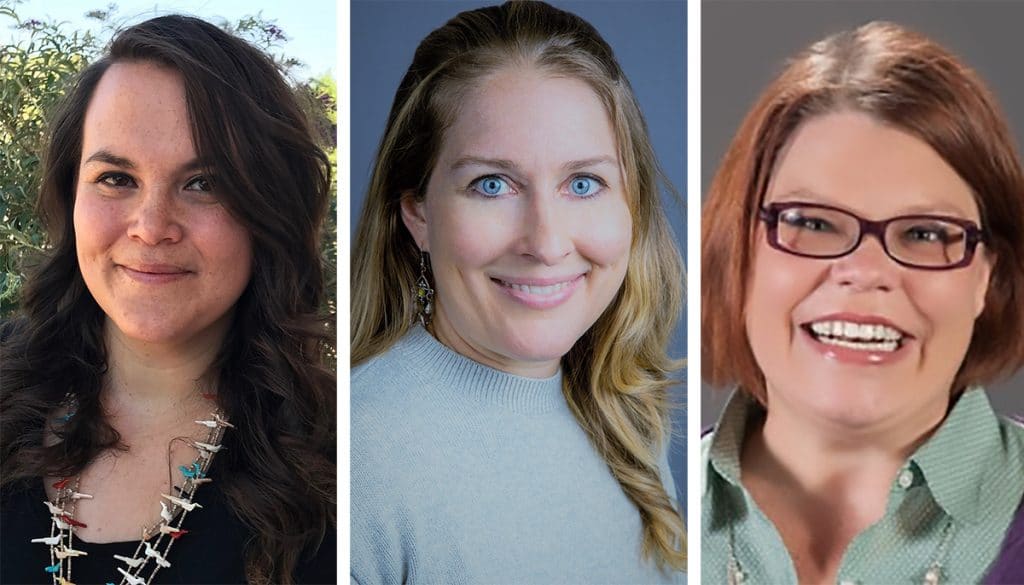Though the COVID-19 quarantine has made it challenging for people to attend conferences and connect with colleagues, more than 100 individuals continued their professional and personal development through a four-part, online Infectious Disease Epidemiology Bootcamp that met each Tuesday in July.
Health care providers, faculty, students, epidemiologists, health department staff and curious community members from across the country joined the bootcamps to learn more about the disease and to discuss their work and community experiences.
Sponsored by the Southwest Health Equity Research Collaborative, the 90-minute bootcamps feature three epidemiologists: Ricky Camplain, assistant professor for Northern Arizona University’s Center for Health Equity and the Department of Health Sciences, Brettania O’Connor, assistant clinical professor for NAU’s Department of Health Sciences and Meghan Warren, professor in NAU’s Department of Physical Therapy and Athletic Training.
The faculty designed the free, 90-minute Zoom bootcamps for people with a basic knowledge of public health, but found a mix of epidemiologists and other medical professionals have been attending.“We are excited to see our northern Arizona community attending these bootcamps,” Camplain said. “They bring different perspectives to the table.”
According to O’Connor in the first bootcamp, “Epidemiology Basics,” widespread testing and isolation of people who test positive for COVID-19 would provide an opportunity to identify infected people quickly and have them isolate, which would prevent disease transmission.
“Early testing, contact tracing, isolation and quarantine can help us to prevent a whole chain of infections,” O’Connor said. “Even if we are not able to stop spread of the infection at the very beginning, any time we are able to block transmission, we can decrease the number of infections.”
O’Connor discussed the epidemic triangle, which includes three elements that create disease––the agent, which is the pathogen; the host, which is the population of people; and the environment, which not only includes the physical environment, but also the social environment, ecology and climatic conditions.
O’Connor said that environmental factors, such as poor sanitation, overcrowding and lack of sufficient clean water for handwashing, can increase the contact between the host and the agent and may allow the pathogen to survive well outside the host to drive the spread of infectious disease.
“All of the points of the triangle come together to determine how a disease is going to spread and to what extent it is going to cause illness and death,” she said.
The importance of screening and testing
In “Screening and Testing,” Camplain also said testing alone does not slow the spread of the virus, but is a tool to monitor the pandemic as it unfolds.
She said that to contain a pandemic, a community needs to respond quickly and respond with the “Box it in” method of widespread community testing, quick isolation of infected people and thorough identification and quarantining of infected contacts, which can make a difference in a pandemic’s outcome.
Camplain said all four parts are crucial to contain COVID-19 and if all four parts are not followed, the number of people infected by the virus can explode, as it has in Arizona, reducing the effectiveness of the “Box it in” method.
She said that communities should also employ widespread public health messaging that recommends social distancing, handwashing, wearing masks and staying at home. She said there also needs to be an increase in number of tests, faster results and development of antibody testing.
“Success requires urgent expansion of our public health capacity as well,” Camplain said.
Widespread testing is on her list of important containment methods, which help to identify asymptomatic people, sick health care workers and ill people in nursing homes and other congregate facilities, such as jails and shelters.
“We need to test contacts of people who have been infected and clusters of people who could be COVID-19 suspected,” Camplain said.
The importance of measuring disease frequency
Warren presented the third bootcamp on “Measures of Disease Frequency.” During the bootcamp, she discussed descriptive epidemiology and the science of an outbreak investigation.
She also discussed the calculation and interpretation of key measures of disease frequency. Prevalence, incidence and mortality measures help understand the burden of disease; case fatality helps understand the severity of disease; and percent positivity assesses testing in a community. These measures can be used to monitor and track disease, as well as help monitor the impact of interventions.
Guidelines from the World Health Organization indicate that percent positivity of less than 5 percent is one of the criteria to indicate if a disease is under control. But, Warren said, most states don’t meet that criteria now, and Arizona has the highest percent positivity of all the states, at more than 20 percent.
“It’s critical to remember that all of the measures are estimates. We still have a lot of work to do to get more precise disease frequency measures for COVID-19,” Warren said.
The last session, “Getting the Most out of Your Data,” was held July 28. The bootcamp sessions as a whole review the basics on key infectious disease agents and transmission dynamics, pandemics, infectious disease epidemiologic methods, vaccination and other infectious disease control measures, screening and testing in public health and data visualization.
To watch the presentations or view the slideshows, visit the Infectious Disease Epidemiology Bootcamp page on the SHERC website.



